The Art of Japanese Fish Prints Explained
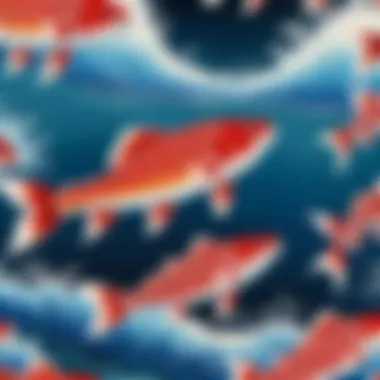
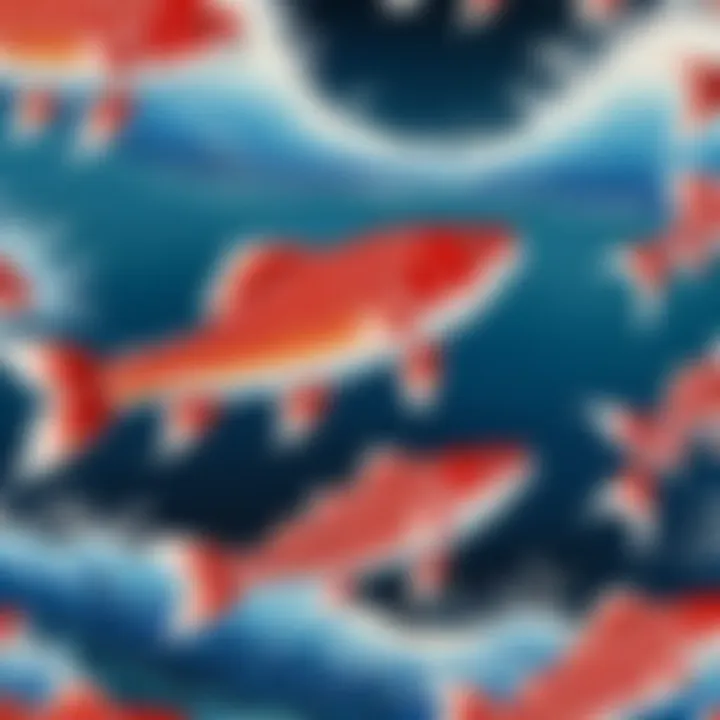
Intro
Japanese fish prints, also known as gyotaku, represent a captivating synthesis of art and nature. Originating from the traditional practices of fishermen in Japan, the methods and materials involved in creating these prints tell a compelling story. This art form merges the natural beauty of fish with artistic expression, offering a unique perspective on the relationship between culture and environment.
Historically, gyotaku was used by fishermen to record their catches, serving both a practical purpose and an aesthetic one. Over time, artists have adopted and adapted these methods, transforming a utilitarian practice into a celebrated art form. The examination of fish prints covers a variety of topics, including their intricate history, diverse techniques, and notable artists who have made significant contributions to this genre.
Through this exploration, we aim to highlight the evolution of fish prints, their cultural significance, and their place in contemporary art. As we delve deeper, we will present a thorough analysis of the artistic techniques employed in gyotaku, alongside insights into its relevance in both traditional and modern contexts.
Preface to Japanese Fish Prints
Japanese fish prints, also known as Gyotaku, carry significant cultural and historical relevance. Their importance in art lies not only in their aesthetic appeal but also in the techniques involved and the traditions they represent. This section sets the stage for a deeper exploration of the unique characteristics and societal importance of these prints. Understanding the basics of Japanese fish prints opens the door to recognizing their impact on art history and their evolution into modern forms.
Definition and Overview
Japanese fish prints are a traditional art form that involves the careful capturing of fish and their textures through a process that imprints the fish onto paper or fabric. This technique allows for the detailed representation of the fish’s anatomy, scales, and fins, creating a lifelike image.
Gyotaku, which means "fish rubbing" in Japanese, initially served a practical purpose for fishermen to document their catches. Over time, it has transformed into a celebrated art form, esteemed for its beauty and intricate detail. The prints are often created using natural inks and dyes, adding to their organic essence.
Historical Context
The roots of Japanese fish prints can be traced back to the mid-19th century, during a period when fishing was an essential part of daily life in Japan. Fishermen utilized this technique to commemorate their achievements and demonstrate their skills. The art form began to gain recognition beyond fishing communities, attracting interest from artists and collectors.
During the Edo period, Gyotaku evolved further as it was combined with other artistic practices such as Ukiyo-e. This cross-pollination of styles enriched the prints, leading to more elaborate designs and thematic representations. Notably, the prints often depicted not just the fish but also varied marine life, integrating elements of Japanese culture and spirituality. This historical blend of functionality and artistry remains significant in understanding the contemporary iterations of Japanese fish prints.
The creation of Japanese fish prints reflects a delicate balance between tradition and artistic expression, capturing the essence of nature while serving as a medium for storytelling.
The Origins of Japanese Fish Prints
Understanding the origins of Japanese fish prints provides crucial insight into their development and significance. Fish printing, known as Gyotaku, is not just an artistic endeavor; it combines practical elements with cultural practices. Examining its origins allows us to appreciate the intricate link between everyday life in Japan and art, revealing the layers of meaning and technique that enrich this form of expression.
Ancient Techniques and Practices
Fish prints have their roots in practical practices among fishermen in Japan. The technique was born from a need to record the size and type of fish caught during fishing expeditions. Fishermen would take a freshly caught fish and create a print using ink or paint, often applying it onto rice paper or fabric. This practice served as a record of their catches and a method of sharing information with others in the community.
The early techniques were rudimentary. Fishermen used brushes to apply ink on one side of the fish, pressing it onto the medium. This method preserved the intricate details and textures of the fish, capturing its physical essence. Over time, these practical prints evolved into a recognized art form, as artists began to appreciate the aesthetic and symbolic values of fish representations.
Influence of Japanese Culture
Japanese culture has always held a deep respect for nature and the sea. Fish, in particular, holds considerable symbolic value in various aspects of life. In Shinto beliefs, for instance, fish can symbolize prosperity and abundance. As a result, fish prints began to take on meanings beyond mere representation.
These prints are often associated with seasonal festivals in Japan, where fish are celebrated not only for sustenance but also as a motif in cultural expressions. Artists began to incorporate traditional motifs and narratives into their works, enriching their aesthetic while embedding cultural significance. This development reflects the harmony between nature and cultural practices, highlighting how art and life were interconnected in historical Japan.
In summary, the origins of Japanese fish prints showcase a blend of practical fishing techniques and profound cultural influences, marking their evolution into a respected art form. The skills and symbolism which were birthed from these practices highlight both the significance of fish in Japanese culture and the transition of Gyotaku from a simple record-keeping technique into a celebrated artistic expression.
Techniques Used in Japanese Fish Prints
The exploration of techniques used in Japanese fish prints is essential in understanding the intricate artistry and history behind this unique form. Techniques not only reflect the skills and knowledge passed down through generations, but they also reveal much about cultural practices and ecological relationships. The techniques aid artists in producing prints that are not only visually striking but also deeply meaningful and representative of the natural world.
Gyotaku: The Traditional Method
Gyotaku, which translates directly to "fish rubbing," is the traditional technique used in creating Japanese fish prints. This method originated with fishermen wanting to document their catches, transforming a mere record into a legitimate art form. The process involves using fresh fish, which is coated in ink or paint, and pressed onto paper or cloth.
Key elements of Gyotaku include:
- The use of actual fish as the primary subject.
- The materials involved, which often focus on natural inks and rice paper.
- The ability to create detailed impressions that capture the unique characteristics of various fish species.
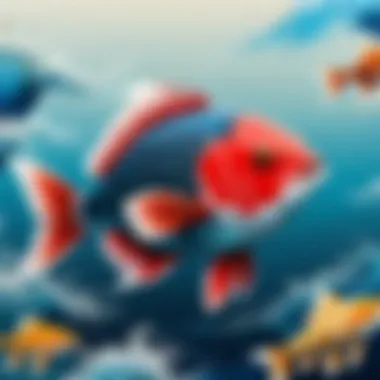
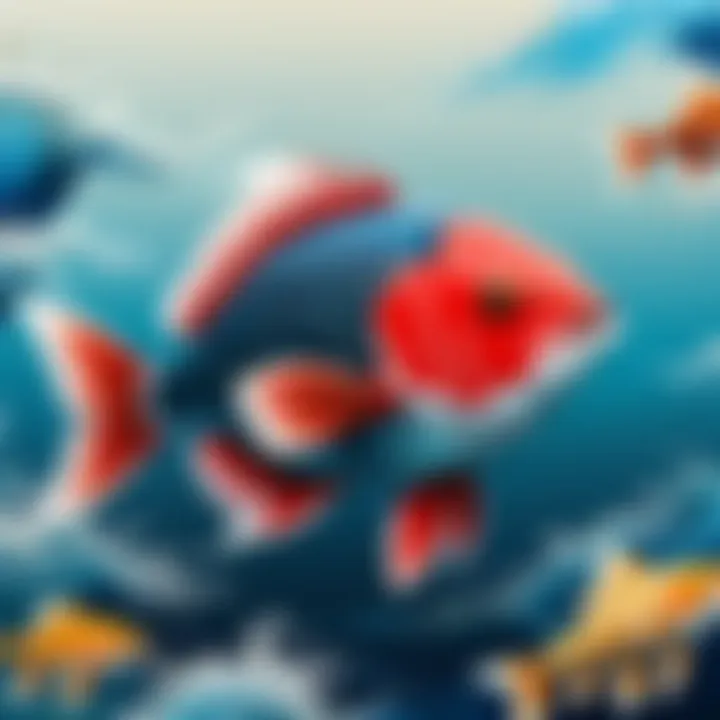
The fidelity of the prints can vary based on the skill of the artist, where each impression could have differing sizes, colors, and textures based on the technique used.
Materials Required
Producing a fish print requires specific materials, ensuring quality and sustainability in the process. Common materials include:
- Fresh fish: Essential for achieving the desired detail in impressions.
- Inks or paints: Traditionally made from natural sources, these inks provide vibrant colors while ensuring environmental safety.
- Paper or fabric: Rice paper or cotton fabric are preferred, as they allow for crisp impressions and durability.
- Brayers and brushes: Used for evenly applying ink onto the fish.
Having high-quality materials greatly improves the outcome of the prints while maintaining the authenticity of the Gyotaku method.
Step-by-step Process
Creating a fish print using Gyotaku involves several deliberate steps:
- Select a fresh fish: Choose a fish that reflects the characteristics desired in the print.
- Prepare the fish: Gently clean the fish, removing any scales or unwanted substances that might affect the print.
- Apply ink: Using a brayer, apply a thin layer of ink evenly across the fish. Ensuring even coverage is crucial for capturing details.
- Press onto paper: Carefully lay the paper over the fish and apply pressure to transfer the ink.
- Lift the print: Gently peel the paper back to reveal the impression.
- Let it dry: Allow the print to dry naturally, preserving the details.
This method emphasizes precision and care, reinforcing the connection between artist and subject.
Variations in Techniques
While Gyotaku remains the cornerstone of Japanese fish printing, several variations have emerged over time. Artists have experimented with different techniques, each bringing a unique perspective:
- Different inks: Some artists use watercolors or pigments for specific artistic effects.
- Background use: Incorporating backgrounds or mixed media enhances the visual depth of prints.
- Digital adaptations: With modern technology, some artists digitally scan fish to create prints, broadening accessibility and creativity.
These variations enrich the art form, illustrating how tradition can evolve while preserving core elements.
"Each print tells a story of artistry, respect for nature, and the cultural significance of the fish within Japanese society."
The exploration of techniques in Japanese fish prints reveals much about cultural practices and the devotion of artists. Understanding these elements fosters appreciation for the rich history and craftsmanship inherent in fish printing.
Cultural Significance of Fish Prints
Japanese fish prints, known as Gyotaku, hold a rich cultural meaning that extends beyond mere aesthetics. They symbolize a deep connection between the people and nature. Through these prints, artists capture not only the appearance of fish but also the spirit, stories, and traditions associated with fishing. This art form is not just about creating visual images; it is a way to document and celebrate the essence of aquatic life, thus reinforcing the importance of ecological balance.
The creation of fish prints often involves fishing practices, which play a crucial part in local traditions. Each print represents more than a single fish; it reflects community values, sustainable practices, and the art of fishing that has been passed down through generations. Therefore, Gyotaku serves as a form of cultural storytelling, preserving the heritage of fishing within Japanese society.
Symbolism in Japanese Culture
In Japanese culture, fish symbolize prosperity, happiness, and good fortune. The fish is often seen as a creature of resilience, adaptable to changing environments. This adaptability resonates with themes prevalent in Japanese philosophy. Moreover, fish are frequently associated with festivals and rituals, illustrating the integral role they play in traditional beliefs.
Artists incorporate various fish species into their prints, each bearing different meanings. For instance, the koi fish represents perseverance and strength, while the sea bream signifies happiness and good fortune. By selecting specific fish, artists convey particular messages, intertwining their work with cultural significance and community wishes.
Role in Traditional Festivals
Fish prints are prominently featured in many traditional Japanese festivals. Festivals often celebrate the community's relationship with the sea and fisheries. During events like the Sanja Matsuri, vibrant fish prints can be found decorating banners and stalls, creating a visual connection between the festivities and the cultural heritage of fishing.
The process of creating fish prints can also be a part of festival activities. Workshops are organized where individuals can participate in making their own prints, allowing them to embody the art form directly. This engagement strengthens communal ties and promotes an appreciation for the tradition of Gyotaku.
In summary, the cultural significance of fish prints is profound. They encapsulate the spirit of Japanese society, connecting art, nature, and tradition in a meaningful way. This intersection not only honors the past but also revitalizes contemporary appreciation for this unique art form.
Prominent Artists and Their Contributions
Japanese fish prints, known as gyotaku, have been profoundly shaped by the contributions of various artists throughout history. Their works serve not only as examples of technical skill but also as reflections of cultural values and artistic philosophies. In this section, we will explore the significance of both historical and contemporary figures in the realm of Japanese fish prints. These artists have played crucial roles in preserving traditional methods while also pushing the boundaries of innovation.
Historical and Contemporary Figures
The history of Japanese fish prints is rich with influential figures who have elevated this art form. Among these, Ukiyo-e artists from the Edo period, such as Hokusai and Hiroshige, are noteworthy. They incorporated elements of nature, including fish, into their more extensive body of work, setting a precedent for future generations.
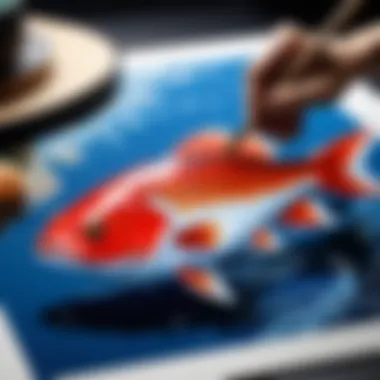
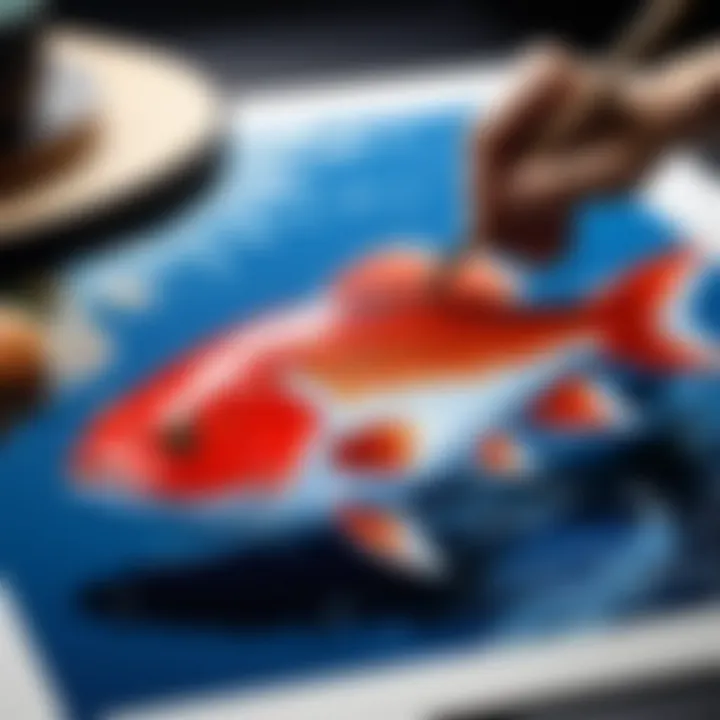
In the modern era, artists like Yoshitomo Nara and Takashi Murakami have engaged with traditional fish printing techniques while infusing contemporary themes. Their approaches have widened the appeal of gyotaku beyond niche art circles, drawing interest from the tech-savvy demographic. It is vital to recognize how these figures have shaped public perception of fish prints and the techniques used in their creation.
Some key contributions include:
- Historical Techniques: Many traditional artists perfected gyotaku methods, documenting their techniques in books and exhibitions.
- Cultural Dialogues: Contemporary artists have initiated discussions around environmental issues through their fish prints.
- Artistic Fusion: The blending of traditional fish print methods with modern aesthetics has created a new genre that captivates a diverse audience.
Innovations in the Art Form
Innovation within the realm of Japanese fish prints has significantly expanded its boundaries and applications. Artists have experimented with materials and techniques, resulting in fresh interpretations of this longstanding tradition.
- Use of New Materials: Beyond the typical rice paper and inks, artists now explore digital printing and textile methods. These developments allow for more versatile artworks.
- Conceptual Art: Some fish prints challenge viewers by combining imagery with narrative elements, addressing themes like depletion of aquatic life and climate change.
- Collaboration with Technology: Many contemporary artists utilize digital platforms to showcase their work, enabling greater reach and interaction with audiences globally.
"The evolution of gyotaku embodies not just a shift in technique but a broader commentary on our relationship with nature."
Overall, the work of both historical and contemporary artists enriches the narrative around Japanese fish prints. It highlights the continuous dialogue between past and present, emphasizing the art form’s adaptability and relevance in today's world. As we move to the next section, consider how these artists have influenced your understanding of this unique cultural practice.
Japanese Fish Prints in Modern Art
Japanese fish prints represent more than just an artistic expression; they are a unique convergence of historical significance and contemporary relevance. This section explores how traditional fish printing techniques have adapted and evolved in contemporary art scenes, highlighting their importance in preserving cultural heritage while also embracing modern trends and technologies.
Contemporary Adaptations
The contemporary adaptations of Japanese fish prints illustrate how traditional art forms can bridge the gap to modern aesthetics. Today, artists are exploring innovative ways to integrate gyotaku into their practices. Some artists experiment with different materials, such as fabric, mixed media, and digital platforms. This refreshes the technique and also attracts a wider audience.
For example, artists like Kishi Eiko have been known to blend traditional printing with modern themes, creating pieces that resonate with today’s issues, such as environmental conservation. These adaptations not only pay homage to history but also invoke discussions relevant to modern society.
Moreover, contemporary galleries now showcase these prints, bringing them to art fairs and exhibitions worldwide. This exposure helps in redefining how Japanese fish prints are perceived, moving from niche interest to appreciation within mainstream art circles.
Intersections with Other Art Forms
The intersections of Japanese fish prints with other art forms highlight their versatile nature and the creative dialogues they inspire. Many contemporary artists collaborate across disciplines, incorporating elements from photography, installation art, and digital media.
- Collaborative Projects: Artists may partner with photographers to document the fish printing process, combining images with prints to create narrative-driven art pieces.
- Installation Art: Some installations feature large-scale fish prints alongside live fish tanks or aquatic environments, provoking a response that engages the viewer's senses.
- Digital Reinterpretation: The advent of digital art has allowed for software-based recreations of gyotaku prints, enabling artists to explore vibrant colors and abstract forms that were not possible in traditional printmaking.
These intersections facilitate a rich dialogue between old and new, preserving the essence of Japanese fish prints while engaging with contemporary themes that resonate with audiences today.
"The beauty of Japanese fish prints lies in their ability to transcend time, adapting to new contexts while preserving their cultural essence."
The Role of Technology in Fish Printing
The intersection of art and technology has created new pathways for traditional practices, including Japanese fish printing. The role of technology in this art form has evolved significantly, introducing enhancements that revolutionize methods, broaden accessibility, and optimize the creative process. This discussion aims to explore the specific elements, benefits, and vital considerations about how technology influences the realm of fish printing.
Digital Innovations
Digital technology plays a transformative role in the creation and dissemination of fish prints. Artists can use programs like Adobe Photoshop or Procreate to design and edit their work before actual printing. These tools allow for precision that traditional methods may lack, enabling artists to experiment with colors, textures, and compositions with relative ease.
One significant advancement is the use of 3D printing technology. Some fish print artists now employ 3D printers to create molds that replicate the natural textures and forms of fish. This technique provides a unique rendition of traditional gyotaku, marrying the old and the new. The result is a print that retains the essence of the original subject, but offers a contemporary look and feel. This blend of tradition and modern technology not only expands the artistic possibilities but also promotes a broader appeal beyond classic art enthusiasts.
"Technology is not just a tool but a means to expand the creative horizons for artists engaged in traditional practices."
Moreover, through social media platforms like Facebook and Reddit, artists can showcase their works to a global audience. This increased visibility allows artists to engage with a community that was previously beyond reach. It fosters a dialogue that encourages feedback, collaboration, and inspiration—factors essential for artistic growth.
Impact on Traditional Techniques
While digital innovations present exciting opportunities, there are implications for traditional techniques. The question arises: how do these advancements affect the authentic practice of fish printing? For many artists, traditional methods remain a core part of their identity. The intricate process of gyotaku, from preparing the fish to applying ink, holds cultural significance and a personal connection that technology can't replicate.
Many artists have started to blend these techniques, using both digital and traditional methods. For instance, some generate digital prints inspired by traditional fish printing aesthetics. This fusion allows artists to maintain a sense of heritage while exploring contemporary art's possibilities. The tactile nature of traditional printmaking serves as a counterbalance to the impersonal nature of digital art, creating a space where both can coexist.
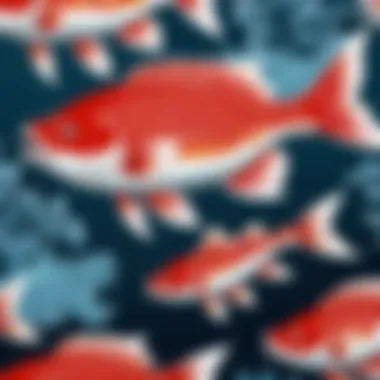
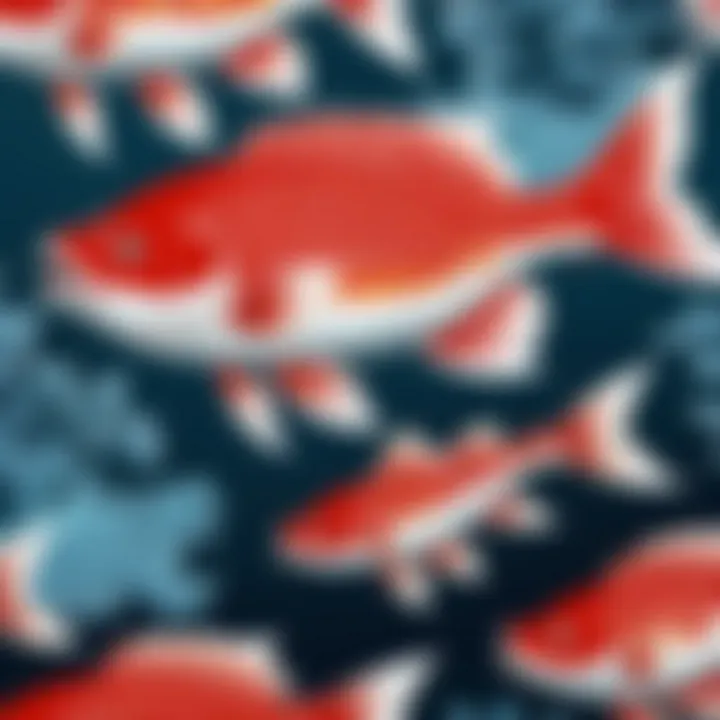
Environmental Considerations
The discussion surrounding environmental considerations in the context of Japanese fish prints has gained prominence in recent years. This importance is anchored in the increasing global awareness of sustainability and conservation, as well as a growing respect for traditional art forms. Japanese fish prints, known as gyotaku, inherently present a unique intersection of art and nature, engaging directly with marine life as their primary subject matter.
Sustainability in Fish Prints
Sustainability within the realm of fish printing involves several key factors. Firstly, the selection of materials is paramount. Artists utilize a variety of inks and papers to create prints. Eco-friendly inks, such as those derived from plant-based sources, help minimize the ecological footprint of the artwork. Additionally, artists are now considering the types of fish they depict. Using species that are sustainably sourced is essential in promoting an ethical practice that respects marine ecosystems.
Moreover, the traditional method of creating fish prints encourages a deeper appreciation for the natural world. In gyotaku, the emphasis lies in using real fish, which allows artists to capture the intricate details and textures of the marine life they work with. This connection often leads artists and spectators alike to reflect on the importance of preserving aquatic habitats.
Conservation Concerns
The conservation of marine environments poses challenges that impact the practice of Japanese fish prints. Overfishing and habitat destruction are significant threats to various fish species, prompting artists to engage in conservation efforts. Recognizing endangered species and advocating for their protection can be a powerful message conveyed through the art of fish printing.
Furthermore, educational initiatives that promote environmental awareness are essential. Collaborations between artists and conservation organizations can foster a dialogue around marine biodiversity. This dynamic interplay between art and environmentalism not only raises awareness but also encourages proactive measures towards conservation.
"Art has the power to inspire, educate, and create change, making it a valuable ally in environmental conservation efforts."
In summary, environmental considerations in Japanese fish prints underscore a crucial narrative. The integration of sustainable practices within the art form is vital for the longevity of both the tradition and the marine ecosystems it seeks to represent. As artists navigate these challenges, they continue to contribute both aesthetically and ethically to the discourse on preserving our planet's rich aquatic heritage.
The Future of Japanese Fish Prints
Emerging Trends
As we look toward the future of Japanese fish prints, several key trends are emerging. These trends reflect a blend of traditional techniques and modern influences. Firstly, there is a noticeable shift towards educational workshops and classes teaching Gyotaku to new generations. This grassroots movement fosters a deeper understanding of this art form within younger demographics, ensuring its longevity.
Furthermore, contemporary artists are experimenting with integrating technology into their practices. Digital fish printing is becoming more prevalent, allowing for the combination of traditional artistry with digital imaging. This innovation opens up a world of possibilities for creativity and expression. It allows artists to manipulate images in ways that were not previously possible, expanding the boundaries of how fish prints can be created and appreciated.
Another significant trend is sustainability. Environmental concerns are prompting artists to choose eco-friendly materials for their prints. This choice not only reflects a commitment to the planet but also appeals to a growing audience that values sustainability in art. Techniques that minimize waste and utilize renewable resources will likely gain traction.
Cultural Preservation Efforts
The preservation of Japanese fish prints is critical in maintaining their cultural integrity and historical significance. Several organizations and individuals are working diligently to document and archive these artworks. By creating comprehensive collections, they safeguard the techniques and stories behind each piece. Such efforts ensure that future scholars and artists can access this rich heritage.
Community engagement plays a crucial role in these preservation strategies. Many local cultural centers are hosting exhibitions and events to educate the public about the significance of fish prints in Japanese culture. By connecting people to the history and relevance of these prints, they foster appreciation and support for the art form.
Additionally, collaborations between traditional artists and modern practitioners are becoming more common. These partnerships can lead to new interpretations while honoring the traditional roots of fish printing. They create a dialogue between generations, helping ensure that the essence of this art form is not lost.
Overall, the future of Japanese fish prints is promising. The interplay of emerging trends and preservation efforts will contribute to the art form's evolution in both aesthetic and cultural dimensions.
"Art is not what you see, but what you make others see." - Edgar Degas
Engaging with Japanese fish prints today means participating in a unique cultural narrative that continues to evolve.
Epilogue
The conclusion serves as a vital component that encapsulates the entirety of the article on Japanese fish prints. It offers an opportunity to reflect on the multifaceted nature of this art form, summing up the historical, artistic, and cultural insights explored throughout. One clear benefit of this section is to reinforce understanding. Readers can revisit key points and assess how they interconnect, deepening their appreciation for fish printing.
Recap of Key Insights
In the examination of Japanese fish prints, several key insights emerge. First, these prints are not merely artistic creations; they are a historical record. Gyotaku, the traditional technique, provides us with a glimpse into the fishing practices of ancient Japan. The cultural symbolism present in these prints highlights their significance in rituals and festivals, illustrating a deep relationship between nature and human activities. Prominent artists, both historical and contemporary, have shaped the medium, pushing it into modern art spaces, ensuring its relevance today.
There is also a notable response to advancements in technology, which has influenced how fish prints are created and perceived. The fusion of digital methods with traditional techniques exemplifies a dynamic evolution within this art form, presenting both challenges and opportunities for artisans.
The Importance of Fish Prints in Art History
Fish prints hold a prominent position in art history, particularly within Japanese visual culture. These prints embody a unique intersection of functionality and aesthetics. Historically, fish printing was more than decoration; it was a practical method for documenting catches, reflecting attitudes toward nature and sustenance. Their evolution highlights shifts in artistic focus, changing from documentation to an expressive art form.
The significance of fish prints extends beyond their visual appeal. They remind us of the ongoing dialogue between environment and culture. As environmental concerns grow, these prints serve as a reminder of both the fragility of marine life and the traditions that have celebrated it. Additionally, their presence in both traditional and contemporary art contexts makes them a critical point of study for understanding artistic evolution.
"Japanese fish prints are windows into a visual culture rich with history and innovation, marking their place within the broader narrative of art."
Collectively, these elements stress the notion that Japanese fish prints are not just a niche interest. They contribute to a broader understanding of art, history, and culture, encapsulating the unique Japanese relationship with nature.







